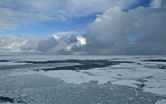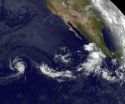(Press-News.org) Despite the rapid retreat of Arctic sea ice in recent years, the ice may temporarily stabilize or somewhat expand at times over the next few decades, new research indicates.
Results of a study by scientists at the National Center for Atmospheric Research (NCAR) appear this week in the journal Geophysical Research Letters (GRL), published by the American Geophysical Union.
The National Science Foundation (NSF), NCAR's sponsor, funded the work.
"As we learn more about climate variability, new and unexpected research results are coming to light," says Sarah Ruth, program director in the Division of Atmospheric and Geospace Sciences, which funds NCAR for NSF. "What's needed now are longer-term observations to better understand the effect of climate change on Arctic sea ice."
The computer modeling study reinforces previous findings by other researchers that the level of Arctic sea ice loss observed in recent decades cannot be explained by natural causes alone, and that the ice will eventually melt away during summer if the climate continues to warm.
But in an unexpected new result, the NCAR research team found that Arctic ice under current climate conditions is as likely to expand as it is to contract for periods of up to about a decade.
"One of the results that surprised us all was the number of computer simulations that indicated a temporary halt to the loss of the ice," says NCAR scientist Jennifer Kay, the lead researcher.
"The computer simulations suggest that we could see a 10-year period of stable ice or even a slight increase in the extent of the ice.
"Even though the observed ice loss has accelerated over the last decade, the fate of sea ice over the next decade depends not only on human activity but also on climate variability that cannot be predicted."
Kay explains that variations in atmospheric conditions such as wind patterns could, for example, temporarily halt the sea ice loss. Still, the ultimate fate of the ice in a warming world is clear, she says.
"When you start looking at longer-term trends, 50 or 60 years, there's no escaping the loss of ice in the summer."
Kay and her colleagues also ran computer simulations to answer a fundamental question: why did Arctic sea ice melt far more rapidly in the late 20th century than projected by computer models?
By analyzing multiple realizations of the 20th century from a single climate model, they attribute approximately half the observed decline to human emissions of greenhouse gases, and the other half to climate variability.
These findings point to climate change and variability working together equally to accelerate the observed sea ice loss during the late 20th century.
Since accurate satellite measurements became available in 1979, the extent of summertime Arctic sea ice has shrunk by about one third.
The ice returns each winter, but the extent shrank to a record low in September 2007 and is again extremely low this year, already setting a monthly record low for July.
Scientists warned just a few years ago that the Arctic could lose its summertime ice cover by the end of the century.
Some research has indicated that Arctic summers could be largely ice-free within the next several decades.
To simulate what is happening with the ice, the NCAR team used a newly updated version of one of the world's most powerful computer climate models.
The software, known as the Community Climate System Model, was developed at NCAR in collaboration with scientists at multiple organizations and with funding by NSF and the Department of Energy.
The research team first evaluated whether the model was a credible tool for the study.
By comparing the computer results with Arctic observations, they verified that, though the model has certain biases, it can capture observed late 20th century sea ice trends and the observed thickness and seasonal variations in the extent of the ice.
Kay and her colleagues then conducted a series of future simulations that looked at how Arctic sea ice was affected both by natural conditions and by the increased level of greenhouse gases in the atmosphere.
The computer studies indicated that the year-to-year and decade-to-decade trends in the extent of sea ice are likely to fluctuate increasingly as temperatures warm and the ice thins.
"Over periods up to a decade, both positive and negative trends become more pronounced in a warming world," says NCAR scientist Marika Holland, a co-author of the GRL paper.
The simulations also indicated that Arctic sea ice is equally likely to expand or contract over short time periods under the climate conditions of the late 20th and early 21st century.
Although the Community Climate System Model simulations provide new insights, the paper cautions that more modeling studies and longer-term observations are needed to better understand the impacts of climate change and weather variability on Arctic ice.
The authors note that it is also difficult to disentangle the variability of weather systems and sea ice patterns from the ongoing impacts of human emissions of greenhouse gases.
"The changing Arctic climate is complicating matters," Kay says. "We can't measure natural variability now because, when temperatures warm and the ice thins, the ice variability changes and is not entirely natural."
INFORMATION:
Arctic ice melt could pause in coming decades
Researchers find unexpected results in study of ice cover in the Arctic
2011-08-19
ELSE PRESS RELEASES FROM THIS DATE:
Better mattresses improve care, cut hospital costs: U of T study
2011-08-19
Toronto, August 17, 2011—Hospitals could reduce health care costs arising from pressure ulcers, commonly known as bedsores, by investing in pressure-reduction mattresses for elderly patients in emergency departments, according to new research from the University of Toronto.
In emergency departments (EDs), elderly patients are at high risk for pressure ulcers in part because they spend hours lying on hard surfaces. The researchers found that while the average cost of upgrading from standard to pressure-redistribution mattresses would be 30 cents per patient, the corresponding ...
Everyday clairvoyance: How your brain makes near-future predictions
2011-08-19
Every day we make thousands of tiny predictions — when the bus will arrive, who is knocking on the door, whether the dropped glass will break. Now, in one of the first studies of its kind, researchers at Washington University in St. Louis are beginning to unravel the process by which the brain makes these everyday prognostications.
While this might sound like a boon to day traders, coaches and gypsy fortune tellers, people with early stages of neurological diseases such as schizophrenia, Alzheimer's and Parkinson's diseases could someday benefit from this research. In ...
Towing Guru Cites Google Maps as Another Tool That Can Improve Search Engine Optimization (SEO) When Online Marketing for Towing Companies
2011-08-19
Towing Guru provides a full range of services in online marketing for towing companies. There are countless opportunities for towing marketing on the Internet. Google's My Maps is an exceptional free tool that can improve a towing company's search engine optimization (SEO), which gets local businesses found by consumers.
What a towing company can do in My Maps is provide a valuable service for consumers. At the same time, My Maps is a powerful towing marketing strategy.
Google My Maps is a customizable tool used to create user-generated maps. A towing company might ...
Ambitious goals = satisfaction
2011-08-19
RIVERSIDE, Calif. (www.ucr.edu) -- Consumers who set ambitious goals have a greater level of satisfaction compared to those who set conservative goals, according to a recently published paper by the Cecile K. Cho, a University of California, Riverside assistant marketing professor.
Cho and her co-author and Gita Venkataramani Johar, a professor at Columbia University, set up two experiments to compare people who set ambitious goals to those who set conservative goals. They focused on situations in which goals were achieved, and measured the level of satisfaction with ...
Common vein condition increases risk for developing life-threating blood clots
2011-08-19
(WASHINGTON, August 17, 2011) –Patients with clinically diagnosed superficial vein thrombosis (SVT), a blood clot in the veins just beneath the skin that commonly resolves on its own without treatment, are four to six times more likely to develop venous thromboembolism (VTE), a dangerous, often life-threatening condition, according to study results published today in Blood, the Journal of the American Society of Hematology (ASH).
Recent studies have shown that patients diagnosed with SVT using ultrasound to confirm the presence of a clot showed increased risk of VTE; ...
New method can speed development of organic semiconductors for flexible displays
2011-08-19
Organic semiconductors hold immense promise for use in thin film and flexible displays – picture an iPad you can roll up – but they haven't yet reached the speeds needed to drive high definition displays. Inorganic materials such as silicon are fast and durable, but don't bend, so the search for a fast, durable organic semiconductor continues.
Now a team led by researchers at Stanford and Harvard universities has developed a new organic semiconductor material that is among the speediest yet. The scientists also accelerated the development process by using a predictive ...
GOES-11 satellite sees Tropical Storms Fernanda and 'little brother' Greg chasing each other
2011-08-19
The Eastern Pacific Ocean is fired up with two tropical storms today, Fernanda and Greg, and both were caught in one image from the GOES-11 satellite. Both appear to be chasing each other to the west, and Fernanda appears a little more organized in satellite imagery and stronger than her "little brother."
The newest tropical storm, Greg, formed this morning, August 17 off the west coast of Mexico from a low previously known as System 99E. Greg is about 135 miles (220 km) south-southwest of Zihuatanejo, Mexico. Because Greg is close to the western coast of Mexico, the ...
Model shows polar ice caps can recover from warmer climate-induced melting
2011-08-19
A growing body of recent research indicates that, in Earth's warming climate, there is no "tipping point," or threshold warm temperature, beyond which polar sea ice cannot recover if temperatures come back down. New University of Washington research indicates that even if Earth warmed enough to melt all polar sea ice, the ice could recover if the planet cooled again.
In recent years scientists have closely monitored the shrinking area of the Arctic covered by sea ice in warmer summer months, a development that has created new shipping lanes but also raised concerns about ...
Moon and Earth may be younger than originally thought
2011-08-19
LIVERMORE, Calif. -- New research using a technique that measures the isotopes of lead and neodymium in lunar crustal rocks shows that the moon and Earth may be millions of years younger than originally thought.
The common estimate of the moon's age is as old as 4.5 billion years old (roughly the same age as the solar system) as determined by mineralogy and chemical analysis of moon rocks gathered during the Apollo missions. However, Lawrence Livermore National Laboratory scientist Lars Borg and international collaborators have analyzed three isotopic systems, including ...
No bones about it: Eating dried plums helps prevent fractures and osteoporosis
2011-08-19
When it comes to improving bone health in postmenopausal women — and people of all ages, actually — a Florida State University researcher has found a simple, proactive solution to help prevent fractures and osteoporosis: eating dried plums.
"Over my career, I have tested numerous fruits, including figs, dates, strawberries and raisins, and none of them come anywhere close to having the effect on bone density that dried plums, or prunes, have," said Bahram H. Arjmandi, Florida State's Margaret A. Sitton Professor and chairman of the Department of Nutrition, Food and Exercise ...
LAST 30 PRESS RELEASES:
Why are there so many Nordic mediators?
Young shark species more vulnerable to extinction
Mobile fetal heart monitoring linked to fewer newborn deaths in Tanzania
Bluey’s dad offered professorial chair in archaeology at Griffith University
Beyond small data limitations: Transfer learning-enabled framework for predicting mechanical properties of aluminum matrix composites
Unveiling non-thermal catalytic origin of direct current-promoted catalysis for energy-efficient transformation of greenhouse gases to valuable chemicals
Chronic breathlessness emerging as a hidden strain on hospitals
Paleontologists find first fossil bee nests made inside fossil bones
These fossils were the perfect home for ancient baby bees
Not everyone reads the room the same. A new study examines why.
New research identifies linked energy, immune and vascular changes in ME/CFS
Concurrent frailty + depression likely boost dementia risk in older people
Living in substandard housing linked to kids’ missed schooling and poor grades
Little awareness of medical + psychological complexities of steroid cream withdrawal
Eight in 10 trusts caring for emergency department patients in corridors, finds BMJ investigation
NASA’s Webb telescope finds bizarre atmosphere on a lemon-shaped exoplanet
The gut bacteria that put the brakes on weight gain in mice
Exploring how patients feel about AI transcription
Category ‘6’ tropical cyclone hot spots are growing
Video: Drivers struggle to multitask when using dashboard touch screens, study finds
SLU research shows surge in alcohol-related liver disease driving ‘deaths of despair’
Rising heat reshapes how microbes break down microplastics, new review finds
Roots reveal a hidden carbon pathway in maize plants
Membrane magic: FAMU-FSU researchers repurpose fuel cells membranes for new applications
UN Member States pledge to increase access to diagnosis and inhaled medicines for the 480 million people living with COPD
Combination therapy shows potential to treat pediatric brain cancer ATRT
Study links seabird nesting to shark turf wars in Hawai‘i
Legal sports betting linked to sharp increases in violent crime, study finds
Breakthrough AI from NYUAD speeds up discovery of life-supporting microbes
New Eva Mayr-Stihl Foundation funding initiative boosts research at University of Freiburg on adaptation of forests to global change
[Press-News.org] Arctic ice melt could pause in coming decadesResearchers find unexpected results in study of ice cover in the Arctic



